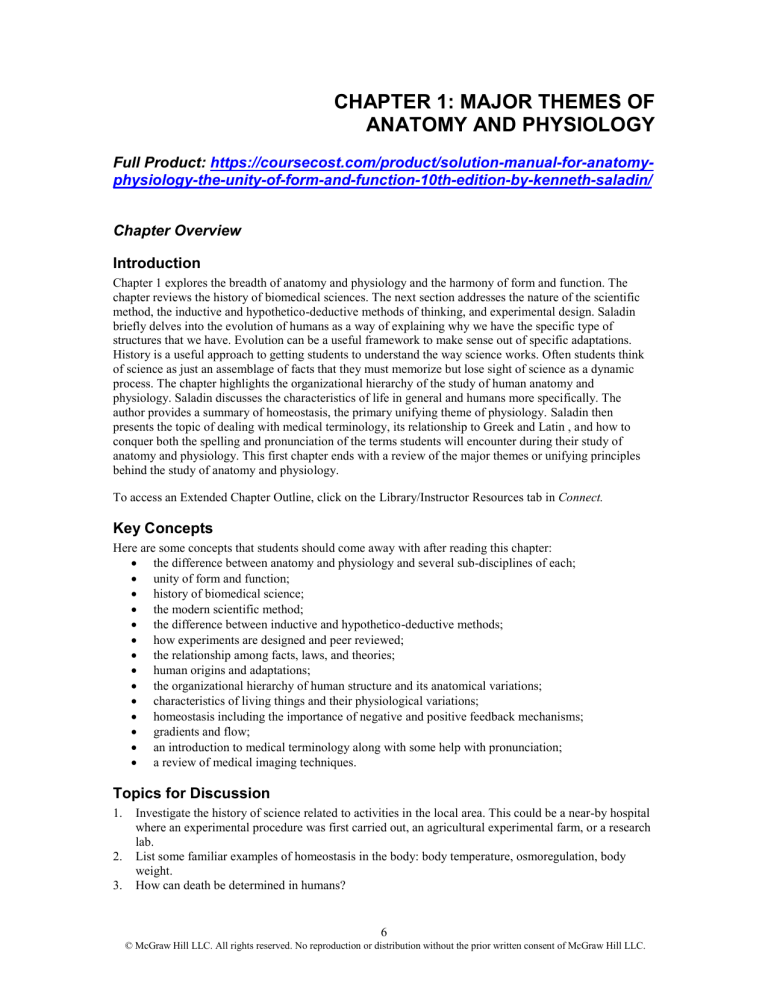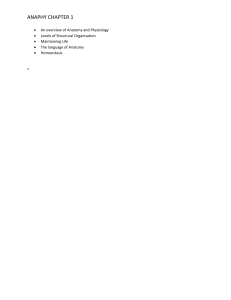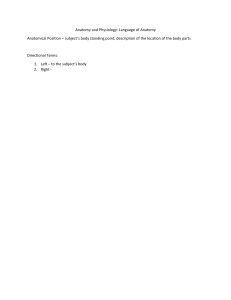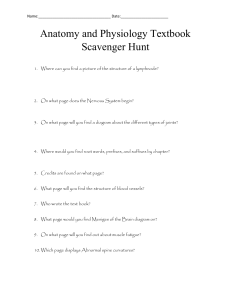Uploaded by
Test Bank and Solution Manual Questions
Anatomy & Physiology Chapter 1 Overview: Key Themes

CHAPTER 1: MAJOR THEMES OF ANATOMY AND PHYSIOLOGY Full Product: https://coursecost.com/product/solution-manual-for-anatomyphysiology-the-unity-of-form-and-function-10th-edition-by-kenneth-saladin/ Chapter Overview Introduction Chapter 1 explores the breadth of anatomy and physiology and the harmony of form and function. The chapter reviews the history of biomedical sciences. The next section addresses the nature of the scientific method, the inductive and hypothetico-deductive methods of thinking, and experimental design. Saladin briefly delves into the evolution of humans as a way of explaining why we have the specific type of structures that we have. Evolution can be a useful framework to make sense out of specific adaptations. History is a useful approach to getting students to understand the way science works. Often students think of science as just an assemblage of facts that they must memorize but lose sight of science as a dynamic process. The chapter highlights the organizational hierarchy of the study of human anatomy and physiology. Saladin discusses the characteristics of life in general and humans more specifically. The author provides a summary of homeostasis, the primary unifying theme of physiology. Saladin then presents the topic of dealing with medical terminology, its relationship to Greek and Latin , and how to conquer both the spelling and pronunciation of the terms students will encounter during their study of anatomy and physiology. This first chapter ends with a review of the major themes or unifying principles behind the study of anatomy and physiology. To access an Extended Chapter Outline, click on the Library/Instructor Resources tab in Connect. Key Concepts Here are some concepts that students should come away with after reading this chapter: the difference between anatomy and physiology and several sub-disciplines of each; unity of form and function; history of biomedical science; the modern scientific method; the difference between inductive and hypothetico-deductive methods; how experiments are designed and peer reviewed; the relationship among facts, laws, and theories; human origins and adaptations; the organizational hierarchy of human structure and its anatomical variations; characteristics of living things and their physiological variations; homeostasis including the importance of negative and positive feedback mechanisms; gradients and flow; an introduction to medical terminology along with some help with pronunciation; a review of medical imaging techniques. Topics for Discussion 1. 2. 3. Investigate the history of science related to activities in the local area. This could be a near-by hospital where an experimental procedure was first carried out, an agricultural experimental farm, or a research lab. List some familiar examples of homeostasis in the body: body temperature, osmoregulation, body weight. How can death be determined in humans? 6 © McGraw Hill LLC. All rights reserved. No reproduction or distribution without the prior written consent of McGraw Hill LLC. 4. Are viruses living things or not? Recently some very large viruses have been found so the question has been taken seriously by some scientists. Sometimes the discussion of the question is more interesting than the actual answer. 5. What are some of the ways that the environment affects the body? Temperature, humidity, and availability of food are some aspects that might come up. 6. What are some ways that fad diets or excesses of certain foods or dietary supplements might affect homeostasis? 7. How are the form and function of body parts related? Give some examples of this interdependence. 8. What is the history of the light microscope? Get the students to make lists of body and cell imaging techniques. 9. How are businesses like living things? Look over the characteristics of living things and think of analogous functions and units within living things. Some examples: businesses with useful characteristics will successfully adapt, grow and, reproduce (viz.: evolution), individual factories are like cells, and corporate hierarchies are similar to the motor hierarchy in the nervous system. 10. How has society's view of science changed over the past 500 years? 11. If you really want a discussion going, try bringing up the Tuskeegee Study of syphilis-infected African-American men who were denied free penicillin (or, apparently, any other meaningful treatment) in the name of science. Sadly, the study was allowed to continue into the 1970’s and was US government funded. 12. How has the pandemic involving COVID-19 changed the way that diseases are investigated? How has the development of the vaccines changed from the normal timeline for development and testing of vaccines? Related Readings Agur, A. and A.F. Dalley. Grant’s Atlas of Anatomy, 14th ed. Hagerstown, MD: Lippencott Williams & Wilkins, 2016. Anon. Scientific Style and Format: the CSE Manual for Authors, Editors, and Publishers, 8th ed. Cambridge; New York: Cambridge University Press, 2014. Anon. Physicians’ Desk Reference, 71st ed. Oradell, NJ: Medical Economics Company, Inc., 2017. The reference book to get information about legal drugs. Baigre, B.S. Scientific Revolutions. Upper Saddle River, NJ: Pearson, 2004. The author provides the background and then reprints original and translated articles. Billman, George E. “Homeostasis: The Underappreciated and Far too Often Ignored Central Organizing Principle of Physiology,” Frontiers in Physiology (11:200), March 10, 2020. Gilroy, A.M., et al. Atlas of Anatomy, 3rd ed. New York: Thieme Medical Publishers, Inc, 2016. Hale, R.B. and T. Coyle. Albinus on Anatomy. New York: Dover Publications, Inc., 1988. This 18th Century classic is still in print but downloadable too. Henry, J. The Scientific Revolution and the Origins of Modern Science. London: Palgrave Macmillan, 2002. Hitti, P.K. The History of the Arabs, 10th ed. London: Palgrave Macmillan, 2002. There is a section on science in this classic reference. Mahsood, E. “Arab Science: Blooms in the Desert,” Nature 416 (2002): 120-122. Maziak, W. “Science in the Arab World: Vision of Glories Beyond,” Science 308 (2005): 1416-1418. Milton, Katharine. “Diet and Primate Evolution,” Scientific American Special Editions 16, 3s, 22-29. Philippe, N et al. 2014. “Pandoraviruses: Amoeba Viruses with Genomes up to 2.5 Mb Reaching that of Parasitic Eukaryotes.” Science 341:281-86, 2013. Saladin, K. Human Anatomy, 6th ed. Dubuque, IA: McGraw-Hill, 2020. Simon, V. “Wanted: Women in Clinical Trials,” Science 308 (2005): 1517. Strahlman, E. “Public Disclosure of Clinical Research,” The Lancet 373 (2005):1319-1320. Topol, Eric J. Deep Medicine: How Artificial Intelligence Can Make Healthcare Human Again. Basic Books, 2019. Zuckerman, Gregory. A Shot to Save the World: The Remarkable Race and Ground-Breaking Science Behind the Covid-19 Vaccine. Penguin Business, 2021. 7 © McGraw Hill LLC. All rights reserved. No reproduction or distribution without the prior written consent of McGraw Hill LLC. Learning Strategies and Techniques 1. Join the Human Anatomy and Physiology Society (HAPS c/o Association Service Group 251 S.L. White Blvd. P.O. Box 2945, LaGrange, GA 30241-2945) and receive the HAPS Educator and other publications of the organization. The society is made up of other anatomy and physiology instructors with problems just like yours. Sometimes great teaching tips come along and, by belonging, you can get new ideas. There are additional advantages to joining: the HAPS list server which will allow you to ask questions of others and get authoritative answers within a few days; receive free copies of the American Association of Anatomists journals; attend regional and annual general conventions. Finally, even if you don’t join, you need to check out the What’s New pages—they will provide updates on the newest research as well as teaching resources. 2. If you are teaching primarily first-semester students, you will find that they are very shy about asking you questions. This is a very destructive habit and needs to be eliminated as soon as possible. Try to reward those few students who do ask questions by praise for that vital habit. In addition to a verbal reward, you might try giving out prizes each class for the best (or any!) question you get. I have used tshirts and bookmarks (get them printed up with your name and access information) but candy (watch the peanut allergy issue), pencils, and pens do just as well. Some of our most important pieces of equipment in science are questions. 3. Can you set up study groups? Get students that are geographically close to try working together with their self-made flash cards. Some institutions go so far as to hire facilitators for these groups. 4. In the lab: correlate cross-sectional views of a human to that of a dissectible mannequin. Try to get copies of X-rays, MRIs, PET, and CT scans to compare with the images in Atlas A which follows this first chapter. 5. Obtain whole kidneys or brains from sheep or other livestock animals and compare them to dissectible mannequin organs or (if you can get them) actual preserved human organs. Ask your students how confident they would have felt 700 years ago going to a physician who had trained primarily using livestock. 6. Emphasize the organizational hierarchy of the body: i.e., from sub-atomic particles to organ systems. 7. Try to get the students to relate negative feedback mechanisms in familiar physical objects to similar mechanisms in their bodies. Some examples might include thermostats and pressure regulators. 8. Have students bring in newspaper clippings or Internet pages related to new biomedical developments. Assign students to further research the specific topic and critique the article. Sometimes the articles are inaccurate and, as the students gain more knowledge as your course progresses, they should be able to pick up on the errors and propose corrections. 9. As the students become more sophisticated, have them look up the journal articles included in each “Learning Strategies and Techniques” section. You can have them write reaction sheets on these. The reaction sheets would include a summary of the major points of the article, how it relates to your course content, and any specific points the student cannot understand. Challenge the student to find independent means to gain this understanding. In this, as in other matters, keep in mind C.A.R.E.'s motto: “If I give a hungry person a fish, I can feed the person for a day; if I teach a person to fish, I can feed that person for a lifetime.” Teach fishing! 10. Try to facilitate study groups of about three students to work together. If students make their own flash cards for studying, they can exchange decks with others after mastering their own set. Try to encourage stronger students to make a cluster with a few weaker students. This latter arrangement can actually help the better students too because it makes the ideas “gel” better when they mentor one another. However, make it clear that the condition should never evolve to parasitism but to mutualism! 11. Some students will be greatly put off at first by those incredible polysyllabic monstrosities that we use every day: terms such as sarcoplasmic reticulum or polymorphonucleocytes. Saladin, in his first chapter, emphasizes the importance of this skill (Deeper Insights 1.4). Convince your students that these terms are really quite easy if one learns the trick of translating them syllable-by-syllable. The words will talk to you and tell you what they mean! Each syllable comes from a Latin or Greek root with a specific meaning. Therefore, these words are actually easier once you get to know them than more familiar English words such as “so,” because the scientific words have but one meaning and that meaning is clear to anyone who has taken the time to learn to decode the roots. In lecture, make sure to point out those roots in context as well so that they can add those study habits to their repertoire. 8 © McGraw Hill LLC. All rights reserved. No reproduction or distribution without the prior written consent of McGraw Hill LLC. 12. Publish or e-mail an anatomy and physiology newsletter every week or so. A desktop publisher would be helpful but is not essential. Other more modern methods of newsletter dissemination could include incorporating social media. The newsletter might have some or all of the following items: recent news items related to the week's work; lab directions and tips (save your voice!); homework questions; safety advice specific to that week's work; additional drawings or information; historical background; and last-minute changes in schedule. 13. If you have long-term and exclusive access to some room space you might try to set up a learning center for anatomy and physiology students. Ideally, this area should not require constant attendance; however, some colleges and universities have work-study help available who might be qualified to act as docents or tutors. Perhaps your university or college library will lend you space and personnel. Here are some ideas for things that could be available: newspaper clippings related to new biomedical developments (make sure the ones you post are accurate!); extra copies of hand-outs; former student projects and term papers to serve as examples; computers with anatomy and physiology software loaded; models, specimens, microscopes and slides, displays, and other simple hands-on items labeled appropriately to go with current lecture/lab activities; audio-visual equipment with materials corresponding to current or recent course content; anatomy atlases, Physicians' desk reference, copies of journals such as Scientific American, The New England Journal of Medicine, Lancet, and JAMA, and medical dictionaries; and sample tests. 14. Several times throughout the semester, have a “one-minute quiz” at the end of class. This is done not for a grade but as a means of making sure you and the student are on the same wavelength together. Everyone should write their names on a blank sheet of paper and answer a good summary question. Here are some examples of summary questions: What was the most important thing we discussed in class today? What was the most confusing thing we did in class today? What was the thing most personally useful that we talked about today? Please write one good question about today's material and answer it. After the lecturer looks over these papers, he/she will be able to better address the specific needs of individual learners. When you hand these back at the beginning of the next class, the students will have useful responses that they can use from that point on. 15. The New England Journal of Medicine has a great many 35mm slide series of pathological conditions available for purchase. The same journal also offers downloads of articles, including graphics, to online subscribers. The content can be included in PowerPointTM presentations. 16. The “Deeper Insights” often provide a basis for discussions or as practical examples of a particular topic. 17. With platforms such as ZOOM available, having scheduled review times is very helpful. You may have to break the ice with some prompts, but I found that students will begin to open up and ask questions or say that they are confused about a topic. As the semester goes on, you will probably be able to enlist some of the better students to help answer questions. Having students explain a topic helps them to remember better and gives a different viewpoint that other students may better understand. 18. Emphasize study skills. Most students in an A&P class were very good high school students who didn’t need to study much. They really don’t know how to actually study. I would give a quiz on the first chapter and make it difficult. That was generally enough of a wake-up call and I would have a line at my office door. I would assure them that a 10/20 on a quiz will not hurt them in the long run and then talk about how they prepared and what changes need to be made. Most students heed the advice and do very well. 19. Many students don’t read the text or even purchase it. Make sure they realize that the e-text is available through Connect. 9 © McGraw Hill LLC. All rights reserved. No reproduction or distribution without the prior written consent of McGraw Hill LLC. 20. Take the time to introduce Connect and all the resources available to the students in Connect as well as the resources available to the instructors. Related Multimedia A Brief History of Biology; Hawkhill Anatomy & Physiology I & II; www.oli.cmu.edu Anatomy & Physiology of the Human Body; www.youtube.com (many other videos are available) Anatomy & Physiology; www.mcphs.edu Anatomy. Cerebellum Corporation. Basic Human Anatomy. HSTN. Biovideo: The Evidence for Evolution; Carolina Evolution; Hawkhill Great Moments in the History of Science; Hawkhill Homeostasis; Films for the Humanities and Sciences How Scientists Think and Work; Hawkhill Human Body Systems at Work. Cambridge Educational (Firm). Interactive Physiology 9-system Suite. Interactive Universe: The Human Body. Winston, Robert M. L. More Evidence and Human Evolution: Insight media National Geographic: The Incredible Human Machine. Marshall, E. G. Negative and Positive Feedback; www.youtube.com NOVA; a series from PBS—check them out from time to time for on-line items Origins of Us; Films for the Humanities and Sciences Review of Biology: Design for Living; Films for the Humanities and Sciences Science and Society; Hawkhill Scientific Method and Values; Hawkhill Scientific Method; www.youtube.com (many other videos are available) The Anatomically Correct World of Anatomy. Cerebellum Corporation. The Body Atlas. Macpherson, Peter. The Human Body Systems at Work. Cambridge Educational (Firm). The Incredible Human Body. Karen Goodman. The Incredible Human Body. Warner Home Video. The Last Neanderthal: Competing Theories of Human Origins. Insight Media. The Living Body. Goldcrest Films and Television. The New Living Body. Films for the Humanities (Firm). The Soul of Science; Hawkhill The Virtual Body. Films for the Humanities and Sciences. Understanding the Human Body: An Introduction to Anatomy and Physiology. Chantilly, VA Teaching Company. What is Homeostasis? www.youtube.com (many other videos are available) What is Science?; Hawkhill William Harvey and the Circulation of Blood; Films for the Humanities and Sciences Women in Science; Hawkhill Working Biologists Today; Hawkhill Related Software Acland’s Cross-Sectional Navigator; Lippincott Williams & Wilkins A.D.A.M: numerous products; A.D.A.M. Anatomica: Digital Atlas of the Human Body; Denoyer-Geppert Anatomy and Physiology Revealed; available as part of Connect from McGraw Hill Module 1 – Animations – Homeostasis: Thermoregulation Animations Found Under Presentation Tools as part of Connect from McGraw Hill Blood Sugar Regulation Homeostasis: Introduction Homeostasis: Digestion Blood Glucose 10 © McGraw Hill LLC. All rights reserved. No reproduction or distribution without the prior written consent of McGraw Hill LLC. Homeostasis: Hypoglycemic Condition Homeostasis: Homeostasis of Blood Glucose Positive and Negative Feedback Cat 3D Dissection; Ward’s Human 3D dissection: Ward’s Interactive Functional Anatomy; Denoyer-Geppert Virtual Labs, available as part of Connect from McGraw Hill: 1st Lab – Virtual Labs Tutorial Applying the Scientific Method – Pillbug Preferences Evidence of Evolution – Fossils and Comparative Anatomy Evidence of Evolution – Molecular Evidence Lab Safety – Hand Washing Procedure Lab Safety – Personal Safety Clip Art Corel Draw; Corel Netter presenter: Human Anatomy Collection; Elsevier Health Several Anatomy Coloring Books are available from various publishers The Library Tab/ Instructor Resources tab in Connect has a wealth of helps available to you. Take the time to peruse the collection for each chapter. Most anything you might need to successfully prepare for your classes, can be found there. Critical Thinking Questions 1. 2. 3. 4. 5. Why was Avicenna (or Ibn Sina) so much more successful in scientific work than his contemporaries in Europe? There is a claim that lycopene, the reddish substance in tomatoes and peppers, is of value in protecting people from Alzheimer Disease. How would you, as a scientist, go about substantiating or refuting this suggestion? Ground sloths are extinct North American relatives of the Central and South American tree sloth species. The living, tropical species are arboreal and eat leaves. What anatomical differences might you expect in the ground versus tree groups? How would you prove to someone that a plant was alive? Using the information in chapter 1, please identify the receptor and the effector mechanisms in temperature control. Critical Thinking Answers 1. 2. 3. 4. There were fewer restrictions on free inquiry in the Islamic world, while in Europe, both anatomy and physiology were taught dogmatically. Avicenna was able to challenge accepted classical sources whenever the evidence indicated it. One can study the brains of those having Alzheimer Disease and compare them with those dying of other causes. The researchers then would retrospectively study the diets of those two groups of people. Scientists have followed this approach and found that lycopene does have promise. However, scientists will ideally perform a very extensive double-blind study (including a placebo) involving thousands of people over many years. At the end of the research, the work would have to be examined statistically, an article written, and then published in a peer-reviewed journal. The arboreal species have front and hind paws that are able to grasp branches. The ground species was probably able to stand upright at least some of the time and was also able to become much larger bodied. Tree sloths feed on foliage so there apparently is little adaptive advantage in their having color vision as was true of the primates. The student should check to see if the plant has the properties given in Section 1.6: The plant has a clear organization with flowers, leaves, stems above ground, and roots underground. The whole works together to draw nutrients from the ground and photosynthesize sugars in the leaves. Microscopic examination shows a plant is made of cells. Biochemical studies show the plant has DNA, proteins, 11 © McGraw Hill LLC. All rights reserved. No reproduction or distribution without the prior written consent of McGraw Hill LLC. 5. lipids, and carbohydrates. Plants can be shown to take molecules from the environment and metabolize them. Plants respond to light, gravity, and water. Obviously, a plant develops from a seed, grows, and reproduces. Plant populations go through evolutionary changes also; just note that some varieties are better adapted to certain environments than others are. You can further challenge your students by giving them some background on virus biology and then asking them to present arguments for or against the question of whether viruses are alive or not. A group of new cells in the base of the brain is the portion of the body that monitors blood temperature (i.e., the sensor) and vasoconstriction and vasodilation of arterioles as the mechanisms that can cause a change in the temperature (i.e., the effectors). Vasoconstriction helps to retain heat by reducing heat loss and also results in shivering (very fast muscular contractions), while vasodilation radiates heat and produces sweat from the sweat glands. Shivering generates heat that will return the body to the set point. Radiation and sweating will lower body temperature back to the set point. Clinical Application Question Sam, 68, suddenly begins to undergo convulsions and is rushed to the emergency room (i.e., the ER). You are the attending physician at the ER that evening and you suspect that he is suffering from a problem in the brain. What imaging method would be the best choice to try to diagnose the problem? Assume that the PET scanner is absolutely not a possibility that night. Clinical Application Answer An MRI will most clearly show views within the brain itself (Deeper Insights 1.5). 12 © McGraw Hill LLC. All rights reserved. No reproduction or distribution without the prior written consent of McGraw Hill LLC.




